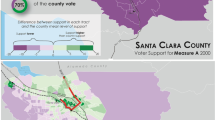Abstract
Federal funding strategies greatly affect investment in urban transportation facilities in the United States. This analysis concentrates on the implications of varying federal aid matching requirements, structuring aid programs as categorical or block grants, and allo cating funds on a discretionary basis or according to formula. Toward this end the effects of recent federal transit aid arrangements are assessed.
Increased federal matching share broadens program participation, especially among smaller cities. However, when offered a choice, communities' preference for more generous federal aid shares is tempered by their election of discretionary grants (e.g., Urban Mass Transportation Administration - UMTA - Section 3) instead of drawing on formula funds (e.g., UMTA Section 5 or highway fund transfers). Formula funds are easier to administer, distributed quite evenly in the UMTA case, and generally more suitable than discretionary funds except where expenditures are large relative to budgets. Categorical aid programs shift local priorities, and thus should be used with caution
Overall, results suggest that one must begin with established transportation objectives against which to evaluate the effectiveness of funding arrangements. In particular, it is critical to make clear the rationale for federal involvement in funding specific programs. Four such federal funding intents are distinguished: compelling national interest, regional development, stimulation of recipient investment in the given program, or financial relief for the aid recipient. Conclusions are drawn as to the desirability of various funding policies according to such program intent.
Similar content being viewed by others
References
AASHTO (American Association of State Highway and Transportation Officials) (1976). Survey of State Aid to Urbanized Areas for Transportation. Washington, DC.
AASHTO (American Association of State Highway and Transportation Officials) (1980). Survey of State Involvement in Public Transportation. Washington, DC.
Advisory Commission on Intergovernmental Relations (1977). Categorical Grants: Their Role and Design. Washington, DC.
Allen, G. R. (1976). “An analysis of subsidy issues in public transportation,” Traffic Quarterly 30: 595–614.
American Public Transit Association (1979). Transit Fact Book. Washington, DC.
Bauer, A.E. (1978). “Solving transportation problems in the federal system: Is there a role for state and local governments?” Publius, The Journal of Federalism 8: 59–76.
Carstens, R.L., Mercier, C.R. and Kannel, E.J. (1976). “Current status of state-level support for transit,” Transportation Research Record 589, “Urban Transportation Finance.”
Charles Rivers Associates, Inc. (1977). Subsidies, Capital Formation and Technological Change: Mass Transit. Prepared for Experimental Technology Incentives Program, National Bureau of Standards, Washington, DC.
Fielding, G. J. (1978). “Performance indicators for transit management,” Transportation 7: 365–379.
Hilton, G. W. (1974). Federal Transit Subsidies. Washington, DC: American Enterprise Institute for Public Policy Research.
Mauro, G. T. (November, 1977). “Mass transit regulation: Procedure governs substance,” Government Executive 34–38.
Mills, W. R. (1979). “Fiscal issues in national transportation policy,” Traffic Quarterly 33:311–325.
Porter, A. L. (1979). Effects of Federal Transportation Funding Policies and Structures: Mass Transit. Washington, DC: U.S. Department of Transportation, Office of the Secretary. (DOT-P-10–80–11).
Porter, A.L., Park, C.Y., Rees, L.P., Connolly, T., Rao, S. and Larson, T.D. (1979). Effects of Federal Transportation Funding Policies and Structures. Washington, DC: U.S. Department of Transportation, Office of the Secretary. (DOT-P-10–80–10).
Smerk, G. M. (1979). “Update on federal mass transportation policy - the Surface Transportation Act of 1978,” Transportation Journal 18: 16–35.
Transportation Research Board (1975). Special Report 155, Research Needs for Evaluating Urban Public Transportation. Washington, DC.
UMTA (Urban Mass Transportation Administration) (1976). Transit Operating Performance and the Impact of the Section 5 Program. Washington, DC: U.S. Department of Transportation.
U.S. Congress, Senate, 91st Congress, 1st Session, Subcommittee on Intergovernmental Relations (1969). “Federal Programs of Grants-in-Aid to State and Local Governments.” Committee Print.
U.S. Congressional Budget Office (1977). Urban Mass Transportation: Options for Federal Assistance. Washington, DC.
U.S. Department of Transportation (1974). A Study of the Urban Mass Transportation Needs and Financing. Washington, DC.
U.S. Department of Transportation (1975). The 1974 National Transportation Report. Washington, DC.
U.S. General Accounting Office (1977). Why Urban Funds Were Seldom Used for Mass Transit. Washington, DC.
U.S. House of Representatives, 95th Congress, Second Session (Oct. 14, 1978). Surface Transportation Assistance Act of 1978. Conference Report, No. 95-1797.
Wachs, M. and Ortner, J. (1979). “Capital grants and recurrent subsidies: A dilemma in American transportation policy,” Transportation 8: 3–19.
Weller, J. L. (1975). “A perspective of transport finance in the United States,” Traffic Quarterly 29: 481–498.
Wells, J. P., Asher, N. J., Brennan, R. J., Crane, J. and Kiernan, J. D. (1970). An Analysis of the Financial and Institutional Framework for Urban Transportation Planning and Investment. Institute for Defense Analysis, Arlington, VA. Prepared for Office of the Assistant Secretary for Policy, Plans, and International Affairs, U.S. Department of Transportation (PB 265 245).
Author information
Authors and Affiliations
Rights and permissions
About this article
Cite this article
Porter, A.L. Transit funding: Implications of federal aid strategies. Transportation 10, 3–22 (1981). https://doi.org/10.1007/BF00165614
Issue Date:
DOI: https://doi.org/10.1007/BF00165614




